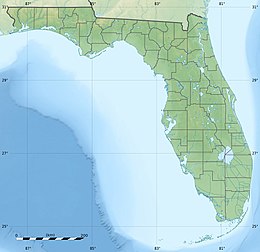San Pablo Island is an unofficial name[1] of a barrier island located off the northeast Atlantic coast of Florida in the United States.[2] It composes the Jacksonville Beaches sitting on the eastern edge of the Jacksonville metropolitan area. The island is about 34 miles (55 km) long. It is separated from the mainland by the Intracoastal waterway to the west, the St. Johns River to the north, and St. Augustine Inlet to the south.
 Coastline of Jacksonville Beach on San Pablo Island. | |
| Geography | |
|---|---|
| Location | North Atlantic |
| Coordinates | 30°17′03″N 81°23′46″W / 30.2841°N 81.3961°W |
| Administration | |
| State | |
| Counties | |
The island's name has been recognized by the city-county consolidated government of Jacksonville[3] and by the municipal government of Atlantic Beach.[4] Multiple other names had been proposed, including Pablo Island, San Diego Island, Diego Island. The goal of uniting a 30-plus mile stretch with its seven communities, some unincorporated, under one name is to provide better opportunities for tourism business.[5]
The northern half of the island is in Duval County, and consists of the cities of Atlantic Beach, Neptune Beach, Jacksonville Beach, as well as a portion of Jacksonville, including Mayport village. The southern half of the island is in St. Johns County, and includes the communities of Ponte Vedra Beach, Sawgrass and Vilano Beach
Naval Station Mayport is at the northern tip of the island, and the mouth of the St. Johns River.[6]
History
editSan Pablo Island has a rich history influenced by various cultural and economic developments. Originally inhabited by Native American tribes like the Timucua, the area saw increased activity in the 19th century as Jacksonville emerged as a key port, and rapid development in the mid-to-late 20th century.
In the 1940s, the U.S. Army Corps of Engineers constructed the Intracoastal Waterway, which connected the San Pablo River to the Matanzas River, completely separating San Pablo from mainland Florida. This development bolstered local shipping, tying the coastal area closer to the Jacksonville economy and leading to suburban growth in the mid-20th century.
Today, San Pablo Island is primarily residential, known for its natural beauty and recreational opportunities like boating, hiking, and golf, contributing to the overall charm of the Jacksonville area.
Transportation
editGrowth on north San Pablo Island was facilitated by roads and bridges built over time to connect it with Jacksonville on the mainland, beginning with Atlantic Blvd in the early 1900s, Beach Blvd (which was constructed on the railway bed of the former Jacksonville and Atlantic Railroad) in the late 1940s, the Butler Blvd expressway in the late 1980s, and finally, the Wonderwood Connector completed in the mid 2000s.[7] The St. Johns River Ferry carries A1A across the St. Johns river near the northern tip of the island.[8]
Six bridges link San Pablo Island to the rest of the Jacksonville metropolitan area, four in Duval County, and two in St. Johns County.[9]
See also
editReferences
edit- ^ McGuinness 2010, p. 162.
- ^ "Jacksonville City Council votes to name San Pablo Island". The Florida Times-Union. Retrieved 2024-08-22.
- ^ "Jacksonville City Council votes to name San Pablo Island". The Florida Times-Union. Retrieved 2024-08-22.
- ^ "Atlantic Beach Proclaims Island to Be Named San Pablo Island". City of Atlantic Beach. October 8, 2024. Retrieved 2024-10-08.
- ^ McGuinness 2010, pp. 162–163.
- ^ "Naval Station Mayport". U.S. Military Installations. October 8, 2024. Retrieved 2024-10-08.
- ^ "Wonderwood Connector Declared Done". Florida Times-Union. October 8, 2024. Retrieved 2024-10-08.
- ^ "St. Johns River Ferry". City of Jacksonville. Retrieved 2024-10-08.
- ^ Langdale, Jennifer B. (November 2000). "Palm Valley Bridge" (PDF). Historic American Engineering Record. Washington, D.C.: Library of Congress. Retrieved March 12, 2023.
Sources
edit- McGuinness, N. (2010). The Beaches: A History and Tour. McGuinness Financial Corporation. ISBN 978-0-615-38519-8. Retrieved 2024-10-07.

